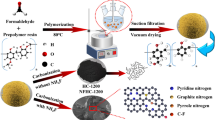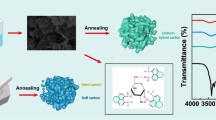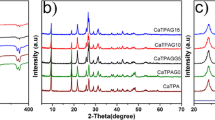Abstract
Electrochemical energy storage devices play key roles in collecting energy from new energy power sources, transferring energy in place and time difference, and supplying energy for those energy consumers. In this work, in order to further improve the high energy density of Li-ion battery, a hard carbon anode is suggested by chosen epoxy as carbon source, accompanied by the simultaneous introduction of three curing agents (dicyandiamide, phytic acid (PA), and ferric acetylacetone). Furthermore, dicyandiamide supplies N-dopant, while PA gives P-dopant and also increases the yield of hard carbon from 23.6 to 40.9%. Based on the synergistic effect of N and P atoms, as well as catalytic effect of Fe, the optimized hard carbon of CNFP-60–700, as Li-ion battery anode, exhibits a reversible capacity of 779.2 mAh g−1 and an initial Coulombic efficiency (ICE) of 58.8% at 0.1 A g−1 for the first cycle, and it still retains a capacity of 508.3 mAh g−1 after 160 cycles.








Similar content being viewed by others
Data availability
The data reported in this manuscript are available from the corresponding author on a reasonable request.
References
Chia SR, Nomanbhay S, Ong MY, Shamsuddin AHB, Chew KW, Show PL (2022) Renewable diesel as fossil fuel substitution in Malaysia: a review. Fuel 314:123137. https://doi.org/10.1016/j.fuel.2022.123137
Yang XD, Zhang JN, Ren SY, Ran QY (2021) Can the new energy demonstration city policy reduce environmental pollution? Evidence from a quasi-natural experiment in China. J Clean Prod 287:125015. https://doi.org/10.1016/j.jclepro.2020.125015
Lehtola T, Zahedi A (2019) Solar energy and wind power supply supported by storage technology: a review. Sustain Energy Technol Assess 35:25–31. https://doi.org/10.1016/j.seta.2019.05.013
Gong JL, Li C, Wasielewski MR (2019) Advances in solar energy conversion. Chem Soc Rev 48:1862–1864. https://doi.org/10.1039/c9cs90020a
Drücke J, Borsche M, James P, Kaspar F, Pfeifroth U, Ahrens B, Trentmann J (2021) Climatological analysis of solar and wind energy in Germany using the Grosswetterlagen classification. Renew Energy 164:1254–1266. https://doi.org/10.1016/j.renene.2020.10.102
Veers P, Dykes K, Lantz E, Barth S, Bottasso CL, Carlson O, Clifton A, Green J, Green P, Holttinen H, Laird D, Lehtomäki V, Lundquist JK, Manwell J, Marquis M, Meneveau C, Moriarty P, Munduate X, Muskulus M, Naughton J, Pao L, Paquette J, Peinke J, Robertson A, Sanz Rodrigo J, Sempreviva AM, Smith JC, Tuohy A, Wiser R (2019) Grand challenges in the science of wind energy. Science 366:1–18. https://doi.org/10.1126/science.aau2027
Chowdhury MS, Rahman KS, Selvanathan V, Nuthammachot N, Suklueng M, Mostafaeipour A, Habib A, Akhtaruzzaman M, Amin N, Techato K (2021) Current trends and prospects of tidal energy technology. Environ Dev Sustain 23:8179–8194. https://doi.org/10.1007/s10668-020-01013-4
Khan ZA, Hussain T, Haq IU, Ullah FUM, Baik SW (2022) Towards efficient and effective renewable energy prediction via deep learning. Energy Rep 8:10230–10243. https://doi.org/10.1016/j.egyr.2022.08.009
Zhang JJ, Li HH, Chen DY, Xu BB, Mahmud MA (2021) Flexibility assessment of a hybrid power system: hydroelectric units in balancing the injection of wind power. Renew Energy 171:1313–1326. https://doi.org/10.1016/j.renene.2021.02.122
Cai K, Wang T, Wang Z, Wang J, Li L, Yao C, Lang X (2023) A cocklebur-like sulfur host with the TiO2-VOx heterostructure efficiently implementing one-step adsorption-diffusion-conversion towards long-life Li–S batteries. Compos B Eng 249:110410. https://doi.org/10.1016/j.compositesb.2022.110410
Kebede AA, Kalogiannis T, Van Mierlo J, Berecibar M (2022) A comprehensive review of stationary energy storage devices for large scale renewable energy sources grid integration. Renew Sust Energ Rev 159:112213. https://doi.org/10.1016/j.rser.2022.112213
Su Y, Yu S, Lang X, Wang T, Qu T, Wang Q, Li L, Yao C, Bai Z, Zhao Y, Cai K (2023) Cross-linked Si@SiC nanowires prepared by vacuum DC arc method embedded in phenolic resin as high electrochemical performance anode active materials for lithium-ion batteries. Electrochim Acta 463:142808. https://doi.org/10.1016/j.electacta.2023.142808
Nzereogu PU, Omah AD, Ezema FI, Iwuoha EI, Nwanya AC (2022) Anode materials for lithium-ion batteries: a review. Appl Surf Sci Adv 9:100233. https://doi.org/10.1016/j.apsadv.2022.100233
Hou JZ, Mao XY, Wang JY, Liang C, Liang JC (2021) Preparation of rice husk-derived porous hard carbon: a self-template method for biomass anode material used for high-performance lithium-ion battery. Chem Phys 551:111352. https://doi.org/10.1016/j.chemphys.2021.111352
Rao XF, Lou YT, Chen J, Lu HC, Cheng B, Wang WT, Fang H, Li HL, Zhong SW (2020) Polyacrylonitrile hard carbon as anode of high rate capability for lithium ion batteries. Front Energy Res 8:3. https://doi.org/10.3389/fenrg.2020.00003
Xie LJ, Tang C, Bi ZH, Song MX, Fan YF, Yan C, Li XM, Su FY, Zhang Q, Chen CM (2021) Hard Carbon anodes for next-generation Li-ion batteries: review and perspective. Adv Energy Mater 11:2101650. https://doi.org/10.1002/aenm.202101650
Drews M, Büttner J, Bauer M, Ahmed J, Sahu R, Scheu C, Vierrath S, Fischer A, Biro D (2021) Spruce hard carbon anodes for lithium-ion batteries. ChemElectroChem 8:4750–4761. https://doi.org/10.1002/celc.202101174
Zhang X, Qu H, Ji W, Zheng D, Ding T, Abegglen C, Qiu D, Qu D (2020) Fast and controllable prelithiation of hard carbon anodes for lithium-ion batteries. ACS Appl Mater Interfaces 12:11589–11599. https://doi.org/10.1021/acsami.9b21417
Li M, Lu J, Chen ZW, Amine K (2018) 30 years of lithium-ion batteries. Adv Mater 30:1800561. https://doi.org/10.1002/adma.201800561
Abe Y, Saito T, Kumagai S (2018) Effect of prelithiation process for hard carbon negative electrode on the rate and cycling behaviors of lithium-ion batteries. Batteries 4:71. https://doi.org/10.3390/batteries4040071
Arnaiz M, Canal-Rodríguez M, Carriazo D, Villaverde A, Ajuria J (2023) Enabling versatile, custom-made lithium-ion capacitor prototypes: benefits and drawbacks of using hard carbon instead of graphite. Electrochim Acta 437:141456. https://doi.org/10.1016/j.electacta.2022.141456
Li Y, Du YF, Sun GH, Cheng JY, Song G, Song MX, Su FY, Yang F, Xie LJ, Chen CM (2021) Self-standing hard carbon anode derived from hyper-linked nanocellulose with high cycling stability for lithium-ion batteries. EcoMat 3:e12091. https://doi.org/10.1002/eom2.12091
Nishi Y (2016) The dawn of lithium-ion batteries. Electrochem Soc Interface 25:71. https://doi.org/10.1149/2.F06163if
Zhang J, Shi ZQ, Wang J, Shi JL (2015) Composite of mesocarbon microbeads/hard carbon as anode material for lithium ion capacitor with high electrochemical performance. J Electroanal Chem 747:20–28. https://doi.org/10.1016/j.jelechem.2015.03.035
Alvin S, Cahyadi HS, Hwang J, Chang W, Kwak SK, Kim J (2020) Revealing the intercalation mechanisms of lithium, sodium, and potassium in hard carbon. Adv Energy Mater 10:2000283. https://doi.org/10.1002/aenm.202000283
Yu P, Tang W, Wu FF, Zhang C, Luo HY, Liu H, Wang ZG (2020) Recent progress in plant-derived hard carbon anode materials for sodium-ion batteries: a review. Rare Met 39:1019–1033. https://doi.org/10.1007/s12598-020-01443-z
Yu CX, Li Y, Wang ZH, Wang XR, Bai Y, Wu C (2022) Surface engineering based on in situ electro-polymerization to boost the initial Coulombic efficiency of hard carbon anode for sodium-ion battery. Rare Met 41:1616–1625. https://doi.org/10.1007/s12598-021-01893-z
Xu R, Sun N, Zhou HY, Chang XQ, Soomro RA, Xu B (2023) Hard carbon anodes derived from phenolic resin/sucrose cross-linking network for high-performance sodium-ion batteries. Battery Energy 2:20220054. https://doi.org/10.1002/bte2.20220054
Sun N, Zhao R, Xu MY, Zhang SH, Soomro RA, Xu B (2023) Design advanced nitrogen/oxygen co-doped hard carbon microspheres from phenolic resin with boosted Na-storage performance. J Power Sources 564:232879. https://doi.org/10.1016/j.jpowsour.2023.232879
Yang PJ, Li TH, Li H, Dang AL, Yuan L (2023) Effect of coal tar pitch modification on the structure and char yield of pyrolysis epoxy resin carbons. Diam Relat Mat 137:110099. https://doi.org/10.1016/j.diamond.2023.110099
Tian YZ, Wang Q, Shen LJ, Cui ZC, Kou LL, Cheng J, Zhang JY (2020) A renewable resveratrol-based epoxy resin with high Tg, excellent mechanical properties and low flammability. Chem Eng J 383:123124. https://doi.org/10.1016/j.cej.2019.123124
Zhang J, Li Z, Zhang L, Yang YX, Wang D (2020) Green synthesis of biomass phytic acid-functionalized UiO-66-NH2 hierarchical hybrids toward fire safety of epoxy resin. ACS Sustain Chem Eng 8:994–1003. https://doi.org/10.1021/acssuschemeng.9b05658
Liu YL, Wang BB, Ma SQ, Xu XW, Qiu JF, Li Q, Wang S, Lu N, Ye JL, Zhu J (2021) Phosphate-based covalent adaptable networks with recyclability and flame retardancy from bioresources. Eur Polym J 144:110236. https://doi.org/10.1016/j.eurpolymj.2020.110236
Gong J, Zhao GQ, Feng JK, An YL, Li TT, Zhang L, Li B, Qian Z (2020) Controllable phosphorylation strategy for free-standing phosphorus/nitrogen cofunctionalized porous carbon monoliths as high-performance potassium ion battery anodes. ACS Nano 14:14057–14069. https://doi.org/10.1021/acsnano.0c06690
Liu YP, Xu CX, Ren WQ, Hu LY, Fu WB, Wang W, Yin H, He BH, Hou ZH, Chen L (2023) Self-template synthesis of peapod-like MnO@N-doped hollow carbon nanotubes as an advanced anode for lithium-ion batteries. Rare Met 42:929–939. https://doi.org/10.1007/s12598-022-02203-x
Qian Y, Jiang S, Li Y, Yi Z, Zhou J, Li TQ, Han Y, Wang YS, Tian J, Lin N, Qian YT (2019) In situ revealing the electroactivity of P-O and P-C bonds in hard carbon for high-Capacity and long-life Li/K-ion batteries. Adv Energy Mater 9:1901676. https://doi.org/10.1002/aenm.201901676
Wang M, Yang Y, Yang ZZ, Gu L, Chen QW, Yu Y (2017) Sodium-ion batteries: improving the rate capability of 3D interconnected carbon nanofibers thin film by boron, nitrogen dual-doping. Adv Sci 4:1600468. https://doi.org/10.1002/advs.201600468
Cheng XW, Guan JP, Tang RC, Liu KQ (2016) Phytic acid as a bio-based phosphorus flame retardant for poly(lactic acid) nonwoven fabric. J Cleaner Prod 124:114–119. https://doi.org/10.1016/j.jclepro.2016.02.113
Gao XM, Shen ZM, Chang GB, Li Z, Zhao HQ (2022) Mechanochemistry induced pore regulation and pyridinic nitrogen doping in anthracite derived carbon for sodium storage. Diam Relat Mat 130:109481. https://doi.org/10.1016/j.diamond.2022.109481
Muruganantham R, Chiang YX, Liu WR (2022) Nitrogen-doped hard carbon derived from agro-food waste of mushroom bags biomass as an anode material for sodium-ion batteries. MRS Energy Sustain 9:313–323. https://doi.org/10.1557/s43581-022-00025-z
Song WJ, Tang YK, Liu JM, Xiao SK, Zhang Y, Gao Y, Yang CS, Liu L (2023) Mild pretreatment synthesis of coal-based phosphorus-doped hard carbon with extended plateau capacity as anodes for sodium-ion batteries. J Alloys Compd 946:169384. https://doi.org/10.1016/j.jallcom.2023.169384
Wu F, Zhou XP, Yu XH (2018) Reaction mechanism, cure behavior and properties of a multifunctional epoxy resin, TGDDM, with latent curing agent dicyandiamide. RSC Adv 8:8248–8258. https://doi.org/10.1039/C7RA13233F
Liu Y, Wang B, Ma S, Xu X, Qiu J, Li Q, Wang S, Lu N, Ye J, Zhu J (2021) Phosphate-based covalent adaptable networks with recyclability and flame retardancy from bioresources. Eur Polym J 144:110236. https://doi.org/10.1016/j.eurpolymj.2020.110236
Fan CL, Zhang RS, Luo XH, Hu Z, Zhou W, Zhang WH, Liu JS, Liu JL (2023) Epoxy phenol novolac resin: a novel precursor to construct high performance hard carbon anode toward enhanced sodium-ion batteries. Carbon 205:353–364. https://doi.org/10.1016/j.carbon.2023.01.048
Liu YX, Guo X, Tian XD, Liu ZJ (2022) Coal-based semicoke-derived carbon anode materials with tunable microcrystalline structure for fast lithium-ion storage. Nanomaterials 12:4067. https://doi.org/10.3390/nano12224067
Han S, Yang J, Li XF, Li W, Zhang XT, Koratkar N, Yu ZZ (2020) Flame synthesis of superhydrophilic carbon nanotubes/Ni foam decorated with Fe2O3 nanoparticles for water purification via solar steam generation. ACS Appl Mater Interfaces 12:13229–13238. https://doi.org/10.1021/acsami.0c00606
Wu M, Zhang J, He BB, Wang HW, Wang R, Gong YS (2019) In-situ construction of coral-like porous P-doped g-C3N4 tubes with hybrid 1D/2D architecture and high efficient photocatalytic hydrogen evolution. Appl Catal, B 241:159–166. https://doi.org/10.1016/j.apcatb.2018.09.037
Wang Z, Liu BL, Xie J, Hu JD, Lu ZJ, Cao YL (2022) Phosphorus/sulfur co-doped hard carbon with a well-designed porous bowl-like structure and enhanced initial coulombic efficiency for high-performance sodium storage. J Alloys Compd 911:164979. https://doi.org/10.1016/j.jallcom.2022.164979
Fedtke M, Domaratius F, Walter K, Pfitzmann A (1993) Curing of epoxy resins with dicyandiamide. Polym Bull 31:429–435. https://doi.org/10.1007/BF00329879
Zhu ZM, Shang K, Wang LX, Wang JS (2019) Synthesis of an effective bio-based flame-retardant curing agent and its application in epoxy resin: curing behavior, thermal stability and flame retardancy. Polym Degrad Stabil 167:179–188. https://doi.org/10.1016/j.polymdegradstab.2019.07.005
Yu CB, Wu T, Yang FH, Wang H, Rao WH, Zhao HB (2022) Interfacial engineering to construct P-loaded hollow nanohybrids for flame-retardant and high-performance epoxy resins. J Colloid Interface Sci 628:851–863. https://doi.org/10.1016/j.jcis.2022.08.117
Shi YW, Liu GZ, Wang L, Zhang HW (2019) Heteroatom-doped porous carbons from sucrose and phytic acid for adsorptive desulfurization and sulfamethoxazole removal: a comparison between aqueous and non-aqueous adsorption. J Colloid Interface Sci 557:336–348. https://doi.org/10.1016/j.jcis.2019.09.032
Fang F, Song P, Ran S, Guo Z, Wang H, Fang Z (2018) A facile way to prepare phosphorus-nitrogen-functionalized graphene oxide for enhancing the flame retardancy of epoxy resin. Compos Commun 10:97–102. https://doi.org/10.1016/j.coco.2018.08.001
Wang H, Li X, Su F, Xie J, Xin Y, Zhang W, Liu C, Yao D, Zheng Y (2022) Core–shell ZIF67@ZIF8 modified with phytic acid as an effective flame retardant for improving the fire safety of epoxy resins. ACS Omega 7:21664–21674. https://doi.org/10.1021/acsomega.2c01545
Yi S, Yan Z, Li X, Wang Z, Ning P, Zhang J, Huang J, Yang D, Du N (2023) Design of phosphorus-doped porous hard carbon/Si anode with enhanced Li-ion kinetics for high-energy and high-power Li-ion batteries. Chem Eng J 473:145161. https://doi.org/10.1016/j.cej.2023.145161
Tao S, Xu W, Zheng J, Kong F, Cui P, Wu D, Qian B, Chen S, Song L (2021) Soybean roots-derived N, P Co-doped mesoporous hard carbon for boosting sodium and potassium-ion batteries. Carbon 178:233–242. https://doi.org/10.1016/j.carbon.2021.03.022
Li XW, Sun JY, Zhao WX, Lai YJ, Yu X, Liu Y (2022) Intergrowth of graphite-like crystals in hard carbon for highly reversible Na-ion storage. Adv Funct Mater 32:2106980. https://doi.org/10.1002/adfm.202106980
Chadha N, Sharma R, Saini P (2021) A new insight into the structural modulation of graphene oxide upon chemical reduction probed by Raman spectroscopy and X-ray diffraction. Carbon Letters 31:1125–1131. https://doi.org/10.1007/s42823-021-00234-5
Zhang JT, Dai LM (2016) Nitrogen, phosphorus, and fluorine tri-doped graphene as a multifunctional catalyst for self-powered electrochemical water splitting. Angew Chem Int Ed 55:13296–13300. https://doi.org/10.1002/anie.201607405
Ma L, Li ZB, Li JL, Dai Y, Qian C, Zhu YF, Wang H, Hui KN, Pan LK, Amin MA, Yamauchi Y, Mai WJ (2021) Phytic acid-induced nitrogen configuration adjustment of active nitrogen-rich carbon nanosheets for high-performance potassium-ion storage. J Mater Chem A 9:25445–25452. https://doi.org/10.1039/D1TA07196C
Tang YH, Chen JJ, Mao ZY, Roth C, Wang DJ (2023) Highly N-doped carbon with low graphitic-N content as anode material for enhanced initial coulombic efficiency of lithium-ion batteries. Carbon Energy 5:e257. https://doi.org/10.1002/cey2.257
Chen C, Huang Y, Meng Z, Lu M, Xu Z, Liu P, Li T (2020) N/O/P-rich three-dimensional carbon network for fast sodium storage. Carbon 170:225–235. https://doi.org/10.1016/j.carbon.2020.08.042
Tao HC, Du SL, Zhang F, Xiong LY, Zhang YQ, Ma H, Yang XL (2018) Achieving a high-performance carbon anode through the P-O bond for lithium-ion batteries. ACS Appl Mater Interfaces 10:34245–34253. https://doi.org/10.1021/acsami.8b11243
Deng M, Dong W, Huang F (2023) High initial Coulombic efficiency hard carbon anodes enabled by facile surface annealing engineering. Chem Asian J 18:210. https://doi.org/10.1002/asia.202300210
Gaikwad MM, Sharma CS (2020) In situ graphitized hard carbon xerogel: a promising high-performance anode material for Li-ion batteries. J Mater Res 35:2989–3003. https://doi.org/10.1557/jmr.2020.293
Li X, Zhang S, Du J, Liu L, Mao C, Sun J, Chen A (2023) Strong interaction between phosphorus and wrinkle carbon sphere promote the performance of phosphorus anode material for lithium-ion batteries. Nano Res 16:9273–9279. https://doi.org/10.1007/s12274-023-5499-z
Qian J, Qiao D, Ai X, Cao Y, Yang H (2012) Reversible 3-Li storage reactions of amorphous phosphorus as high capacity and cycling-stable anodes for Li-ion batteries. Chem Commun 48:8931–8933. https://doi.org/10.1039/c2cc34388f
Xie F, Xu Z, Guo ZY, Titirici MM (2020) Hard carbons for sodium-ion batteries and beyond. Prog Energy 2:042002. https://doi.org/10.1088/2516-1083/aba5f5
Augustyn V, Come J, Lowe MA, Kim JW, Taberna P-L, Tolbert SH, Abruña HD, Simon P, Dunn B (2013) High-rate electrochemical energy storage through Li+ intercalation pseudocapacitance. Nat Mater 12:518–522. https://doi.org/10.1038/nmat3601
Acknowledgements
We are grateful for the support of the National Natural Science Foundation of China (22075082), Natural Science Foundation of Shanghai (No. 19ZR1413000, 13ZR1411900), Shanghai Alliance Plan (No. LM201881, LM201751), Shanghai Leading Academic Discipline Project (B502), and Shanghai Key Laboratory Project (08DZ2230500).
Author information
Authors and Affiliations
Contributions
CZ contributed to conceptualization, investigation, and methodology; HG contributed to writing—original draft and data curation; BZ contributed to conceptualization and data curation; ML, XT, and WG contributed to formal analysis and validation; YZ contributed to methodology; CZ contributed to conceptualization and project administration. All authors were involved in writing and editing the manuscript.
Corresponding authors
Ethics declarations
Competing interests
The authors declare no competing interests.
Additional information
Publisher's Note
Springer Nature remains neutral with regard to jurisdictional claims in published maps and institutional affiliations.
Supplementary Information
Below is the link to the electronic supplementary material.
Rights and permissions
Springer Nature or its licensor (e.g. a society or other partner) holds exclusive rights to this article under a publishing agreement with the author(s) or other rightsholder(s); author self-archiving of the accepted manuscript version of this article is solely governed by the terms of such publishing agreement and applicable law.
About this article
Cite this article
Zhao, C., Guo, H., Zhu, B. et al. Epoxy resin-derived N, P co-doping hard carbon with improved yield and anode performance in Li-ion battery. Ionics 30, 1971–1981 (2024). https://doi.org/10.1007/s11581-024-05387-7
Received:
Revised:
Accepted:
Published:
Issue Date:
DOI: https://doi.org/10.1007/s11581-024-05387-7




